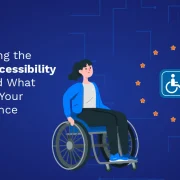
The Importance of Learning Paths in Employee Training
Not every course created has the quality of being a stand-alone one, especially when it comes to employee training and development. Some courses, in essence, are meant to be grouped with others to enhance the overall learning experience. That’s where learner paths or learning paths become relevant.
If you are confused about learning paths, they are a collection of thoughtfully grouped courses designed to enable learners to master a specific program or topic. Learning paths are especially useful and crucial for upskilling individuals belonging to the same team or sharing similar responsibilities.
With learner paths, tutors can give learners the control of choice, making it easier for both parties. Implementing a learning path in employee training and development has numerous benefits. Below is a discussion of the importance of learning and development.
Table of Contents:
- What are Learning Paths for Employees?
- What is the Purpose of a Learning Path?
- What are the Benefits of Learning Path in Employee Training & Development
- How Do You Create a Learning Path for Employees?
- Step 1: Define Goals
- Step 2: Understand Employee Needs and Assess Skills Gap
- Step 3: Formulate the Learning Path Framework
- Step 4: Pick the Appropriate Learning Styles and Materials
- Step 5: Set Concrete Milestones and Assessments
- Step 6: Monitor Progress and Provide Feedback
- Step 7: Continuously Update and Improve the Path
- Bottom Line
What are Learning Paths for Employees?
A learning path is a structured series of training programs for an employee. These educational programs can be courses or modules aligned to guide employees through their professional development journey. Employees in any organization are required to follow specific roles, skills, or career goals. This helps them acquire and master relevant competencies over time.
For example, a sales representative may need to follow a learning path that focuses on negotiation skills and CRM tools. On the other hand, an IT developer’s learning path might include coding languages, software testing, project management, etc.
Learning paths create a clear progression structure for employees. These eLearning modules are further bifurcated into manageable steps that ensure that employee development is attainable and measurable.
Key Features of Employee Learning Paths:
- Personalization: Learning paths for employees are customized to fit into individual roles, strengths, and aspirations in their careers.
- Flexibility: Corporate learning paths are self-paced learning with constant updates to the approach.
- Goal-Oriented: These are linked to meeting outcomes and end objectives of the organization.
- Trackable: These employee learning paths enable tracking of progress and milestones through metrics and analytics.
Corporate learning paths in training can greatly facilitate continuous learning, upskilling, and reskilling. These can motivate employees and promote developing workplace situations.
Also Read: Pro Tips to Create Custom eLearning Paths
What is the Purpose of a Learning Path?
A learning path is a strategic learning roadmap. It is a well-planned structure that includes interactive training and development activities. The ultimate goal is to upgrade employees’ skills, knowledge, and competencies and help them excel at their jobs. Learning paths are win-win for both employees and employers, as they help align individual growth with organizational goals.
Key Objectives of Corporate Learning Paths:
- Skill Attainment: These paths give employees the specific skills they want for a given job.
- Career Advancement: The aim is to provide employees with definite routes for advancement within an organization.
- Consistency: Every employee should be trained uniformly.
- Engagement: Employees are motivated and driven by clear goals and measurable milestones.
- Adaptability: These learning paths prepare employees to address changing industry trends and challenges.
What are the Benefits of Learning Path in Employee Training & Development
Here are the top 9 benefits of curating learning paths for employees:
1. Brings More Structure
With learner paths, training programs become more structured and sequenced. Although learners can choose the pace and pathways of progression, administrators can control the order in which the courses are assigned and the duration for which a course becomes available.
Learning paths for employees can also be implemented to address the needs of multiple learners or teams. Administrators can identify an individual’s specific needs and assign respective courses to that individual.
2. Enables Self-Paced Learning
Employees differ in their abilities to learn, grasp, and implement the information they perceive. Without a learning path, they will be forced to follow a specific pace, making it harder for them to catch up with the rest.
One of the most striking benefits of learner paths is that they make learning self-paced. Learners can choose when, where, and what they want to learn. More precisely, the control of choice shifts from the administrator to the learners.
3. Makes it Easier to Define And Pursue Goals
Training programs fail because they lack a clear goal. Fortunately, learner paths eliminate such inconsistencies and bring more meaning to the learning process with well-defined goals.
As these pieces of training become purpose-driven, employees will feel a sense of accomplishment and have reasons to start the program. With instant and visible roadmaps, learners will be motivated to complete the course, enhancing the importance of training. They will also learn how far they are from reaching their goals.
4. Helps in Accelerating L&D Goals
Employee training aims to upskill individuals and align their acquired skills with the organization’s growth and requirements. This process is collectively known as learning and development, which is crucial for a company’s long-term success.
With learner paths, companies can align the courses to address the organization’s immediate needs. As several modules collectively contribute to the final goal, employees can quickly implement the skills acquired from each lesson.
5. Saves Admin Time
Whether an IT employee or an administrator, their time is an invaluable resource. For admin users, utilizing learning paths will help them enroll a considerable number of learners at the same time while leaving the rest to their comfort and pace of learning.
As there will be a well-designed roadmap for reaching the intended goals, learners will be self-sufficient: reducing the burden placed on the administrators. Additionally, when learners complete a course, they are automatically enrolled in the next, without admin intervention.
6. Promotes Continuous Feedback
Training alone will not help employees acquire new skills and knowledge. Instead, they must receive continuous and constructive feedback to ensure that they are on the right track.
A learner path, multiple assessments, and methods for applying the acquired knowledge will help the employee and the organization assess whether the programs are useful from a business perspective.
A learning path covers multiple modules, so admins can monitor how each employee engages with each module and tweak the entire program if needed. Feedback is almost immediate, so employees also have the opportunity to correct themselves.
7. Makes Learning a Continuous Process
Unlike a few decades ago, employees are now more aware of the importance of upskilling and are keen on learning new things. Of course, an individual’s “keenness” to learn depends on how interactive and relevant the lessons are.
Additionally, employees tend to prefer organizations that are more enthusiastic about professional development. With learning paths, organizations can continually update their training programs and will have the flexibility to add more modules in between.
8. Small Bites Are Better for Retention
Learner paths make it easier to deliver relevant information in an organized manner throughout a stipulated period. This is especially critical to engaging and retaining employees, as training cannot be performed once and left there.
To make the acquired information useful and profitable for the organization, it must be repeatedly delivered engagingly via multiple channels.
Learning paths that follow bite-sized learning (also known as microlearning) will reduce clutter and cognitive load for employees. Smaller chunks can also improve retention, as learning is more understandable, with a few takeaways and more time to absorb.
9. Nurtures a Learning Environment
As mentioned, employees are inclined to stay with organizations that invest in their skill development. Learning paths can help companies foster an environment in which upskilling is considered a continuous and essential process.
As organizations invest more in training, they can understand the overlooked gaps in employee development, which can boost productivity when resolved. Starting with onboarding, learning paths will make it easier for employees to attain excellence when a clearly defined path is set to follow.
When learning becomes a habit, companies can also reduce costs associated with expensive workshops or frequent talent hunts. As employees enhance their skillsets, meeting the skills demands across multiple departments will be seamless.
Learning will also no longer be overwhelming, as employees can estimate the time and effort required to master a specific topic.
How Do You Create a Learning Path for Employees?
Here’s a step-by-step guide that will help you understand how to create a learning path for employees:
Step 1: Define Goals
Begin by defining the goals of your training program. Be prepared with answers to questions like – What are the specific skills required for employees to do well in their roles? Align these objectives with broader organizational priorities. Some examples of organizational goals could be improving productivity, innovating, or enhancing customer satisfaction.
Step 2: Understand Employee Needs and Assess Skills Gap
Check the skills and competencies of your employees by assessment, feedback, and performance reviews. Identify the strong points and weaknesses of employees.
Step 3: Formulate the Learning Path Framework
Structure the content in an orderly fashion, from foundational material to advanced ideas. Define modules or stages with well-defined objectives to create natural subdivisions of the path.
Step 4: Pick the Appropriate Learning Styles and Materials
Determine which formats best suit your target audience—eLearning, workshops, videos, or gamified modules. Mix methods to appeal to different styles.
Step 5: Set Concrete Milestones and Assessments
Measurable objectives at each stage of the learning path: Use quizzes, simulations, or practical assignments to monitor progress and consolidation.
Step 6: Monitor Progress and Provide Feedback
Analytics tools or the learning management system (LMS) can be used to monitor employee progress. Regular feedback can keep employees motivated and help them overcome challenges.
Step 7: Continuously Update and Improve the Path
Review and update the learning path as business needs and industry trends change. Add new modules, remove outdated content, and incorporate new technologies.
Also Read: How to Design Learning Path for an Employee Training & Development
Bottom Line
Training and development programs are important to implement learning paths in employee training and development, as they will transform an organization’s outlook and portray it as a destination employer. The key is to formulate learner paths and strategies that align with the organization’s interests and requirements and that of the employees. Talk to our experts and connect with Hurix Digital to explore key employee learning paths.
Our team will help to understand and implement corporate learning paths for long-term organizational success!






